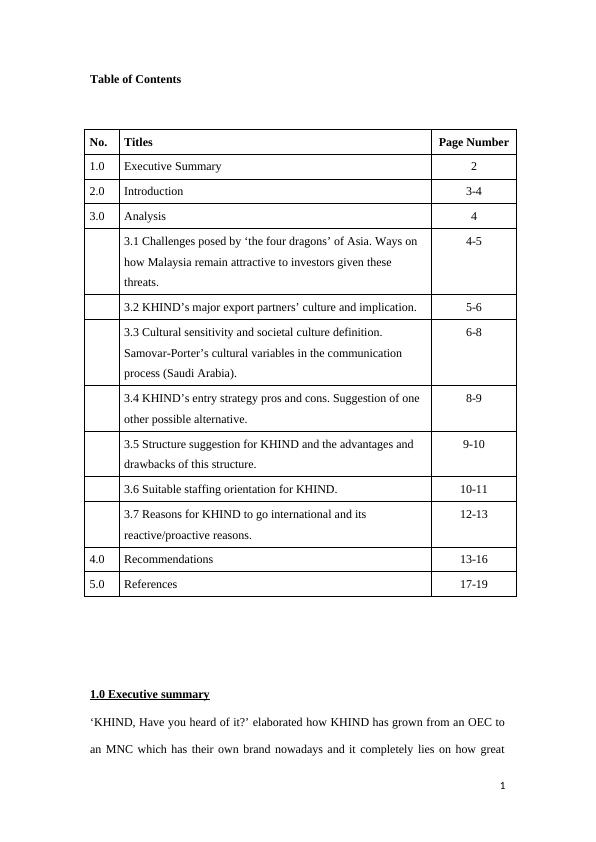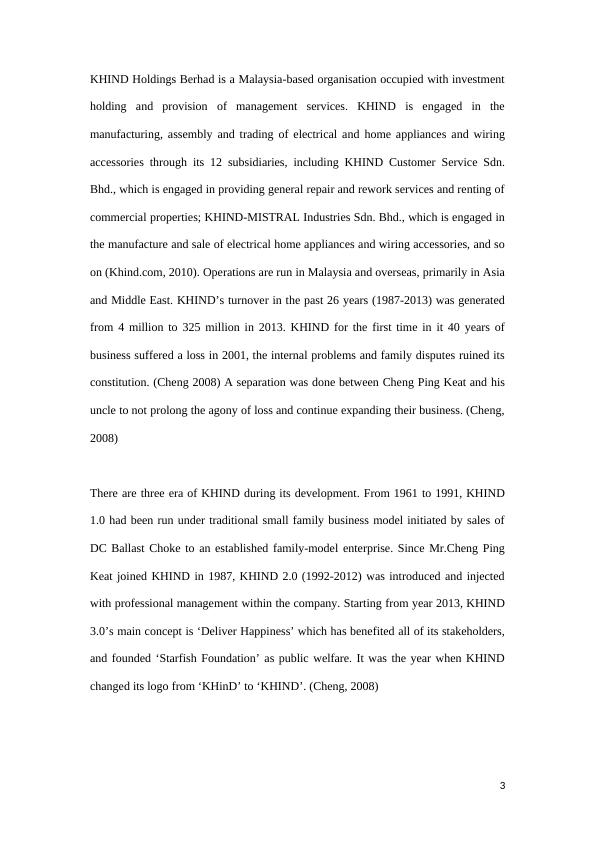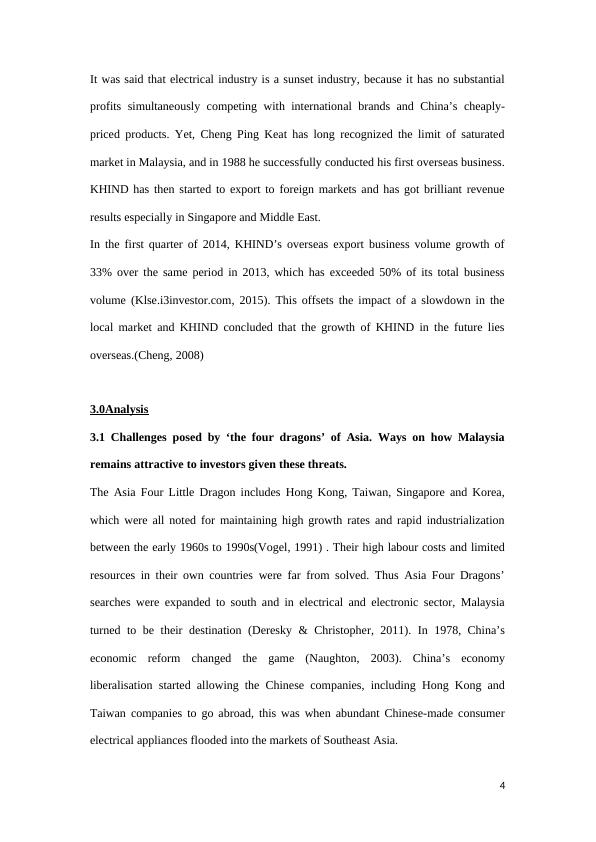Structure suggestion for KHIND PDF
19 Pages4832 Words117 Views
Added on 2021-11-16
Structure suggestion for KHIND PDF
Added on 2021-11-16
ShareRelated Documents
Table of Contents
No. Titles Page Number
1.0 Executive Summary 2
2.0 Introduction 3-4
3.0 Analysis 4
3.1 Challenges posed by ‘the four dragons’ of Asia. Ways on
how Malaysia remain attractive to investors given these
threats.
4-5
3.2 KHIND’s major export partners’ culture and implication. 5-6
3.3 Cultural sensitivity and societal culture definition.
Samovar-Porter’s cultural variables in the communication
process (Saudi Arabia).
6-8
3.4 KHIND’s entry strategy pros and cons. Suggestion of one
other possible alternative.
8-9
3.5 Structure suggestion for KHIND and the advantages and
drawbacks of this structure.
9-10
3.6 Suitable staffing orientation for KHIND. 10-11
3.7 Reasons for KHIND to go international and its
reactive/proactive reasons.
12-13
4.0 Recommendations 13-16
5.0 References 17-19
1.0 Executive summary
‘KHIND, Have you heard of it?’ elaborated how KHIND has grown from an OEC to
an MNC which has their own brand nowadays and it completely lies on how great
1
No. Titles Page Number
1.0 Executive Summary 2
2.0 Introduction 3-4
3.0 Analysis 4
3.1 Challenges posed by ‘the four dragons’ of Asia. Ways on
how Malaysia remain attractive to investors given these
threats.
4-5
3.2 KHIND’s major export partners’ culture and implication. 5-6
3.3 Cultural sensitivity and societal culture definition.
Samovar-Porter’s cultural variables in the communication
process (Saudi Arabia).
6-8
3.4 KHIND’s entry strategy pros and cons. Suggestion of one
other possible alternative.
8-9
3.5 Structure suggestion for KHIND and the advantages and
drawbacks of this structure.
9-10
3.6 Suitable staffing orientation for KHIND. 10-11
3.7 Reasons for KHIND to go international and its
reactive/proactive reasons.
12-13
4.0 Recommendations 13-16
5.0 References 17-19
1.0 Executive summary
‘KHIND, Have you heard of it?’ elaborated how KHIND has grown from an OEC to
an MNC which has their own brand nowadays and it completely lies on how great
1

KHIND has adapted to the changing environments and challenges over 50 years.
(Cheng, 2008)
KHIND Holdings Berhad is a well-known company that is occupied with investment
holding and provision of management services. It was listed on the KLSE on 12
August 1998, and has 12 different subsidiaries that manufacture and distribute their
world-class quality electrical products in Malaysia, and of course, exporting to over
50 countries globally (Khind.com, 2010).
Despite KHIND’s high brand awareness and high quality electrical appliances,
Malaysia’s electrical and electronic market is flooded with other international brands,
mainly from Europe and Japan, for example Philips, Panasonic, Sharp, and Korean
brands like Samsung, LG, etc.(Khind, 2012) Fortunately, KHIND had outstanding
results in foreign markets as it is often the only Malaysian-made brand in those
markets, and their products are relatively competitive in those markets especially in
Africa and Middle East(Cheng,2008). Thus, exporting is a path for KHIND to arise to
a next level of success.
KHIND’s products are strong enough to stay in foreign markets, and KHIND has
already focused in West Asia, Asia Pacific and Europe. Therefore, a new market
should be attempted to seek for more room of development, for example, Vietnam.
2.0 Introduction
2
(Cheng, 2008)
KHIND Holdings Berhad is a well-known company that is occupied with investment
holding and provision of management services. It was listed on the KLSE on 12
August 1998, and has 12 different subsidiaries that manufacture and distribute their
world-class quality electrical products in Malaysia, and of course, exporting to over
50 countries globally (Khind.com, 2010).
Despite KHIND’s high brand awareness and high quality electrical appliances,
Malaysia’s electrical and electronic market is flooded with other international brands,
mainly from Europe and Japan, for example Philips, Panasonic, Sharp, and Korean
brands like Samsung, LG, etc.(Khind, 2012) Fortunately, KHIND had outstanding
results in foreign markets as it is often the only Malaysian-made brand in those
markets, and their products are relatively competitive in those markets especially in
Africa and Middle East(Cheng,2008). Thus, exporting is a path for KHIND to arise to
a next level of success.
KHIND’s products are strong enough to stay in foreign markets, and KHIND has
already focused in West Asia, Asia Pacific and Europe. Therefore, a new market
should be attempted to seek for more room of development, for example, Vietnam.
2.0 Introduction
2

KHIND Holdings Berhad is a Malaysia-based organisation occupied with investment
holding and provision of management services. KHIND is engaged in the
manufacturing, assembly and trading of electrical and home appliances and wiring
accessories through its 12 subsidiaries, including KHIND Customer Service Sdn.
Bhd., which is engaged in providing general repair and rework services and renting of
commercial properties; KHIND-MISTRAL Industries Sdn. Bhd., which is engaged in
the manufacture and sale of electrical home appliances and wiring accessories, and so
on (Khind.com, 2010). Operations are run in Malaysia and overseas, primarily in Asia
and Middle East. KHIND’s turnover in the past 26 years (1987-2013) was generated
from 4 million to 325 million in 2013. KHIND for the first time in it 40 years of
business suffered a loss in 2001, the internal problems and family disputes ruined its
constitution. (Cheng 2008) A separation was done between Cheng Ping Keat and his
uncle to not prolong the agony of loss and continue expanding their business. (Cheng,
2008)
There are three era of KHIND during its development. From 1961 to 1991, KHIND
1.0 had been run under traditional small family business model initiated by sales of
DC Ballast Choke to an established family-model enterprise. Since Mr.Cheng Ping
Keat joined KHIND in 1987, KHIND 2.0 (1992-2012) was introduced and injected
with professional management within the company. Starting from year 2013, KHIND
3.0’s main concept is ‘Deliver Happiness’ which has benefited all of its stakeholders,
and founded ‘Starfish Foundation’ as public welfare. It was the year when KHIND
changed its logo from ‘KHinD’ to ‘KHIND’. (Cheng, 2008)
3
holding and provision of management services. KHIND is engaged in the
manufacturing, assembly and trading of electrical and home appliances and wiring
accessories through its 12 subsidiaries, including KHIND Customer Service Sdn.
Bhd., which is engaged in providing general repair and rework services and renting of
commercial properties; KHIND-MISTRAL Industries Sdn. Bhd., which is engaged in
the manufacture and sale of electrical home appliances and wiring accessories, and so
on (Khind.com, 2010). Operations are run in Malaysia and overseas, primarily in Asia
and Middle East. KHIND’s turnover in the past 26 years (1987-2013) was generated
from 4 million to 325 million in 2013. KHIND for the first time in it 40 years of
business suffered a loss in 2001, the internal problems and family disputes ruined its
constitution. (Cheng 2008) A separation was done between Cheng Ping Keat and his
uncle to not prolong the agony of loss and continue expanding their business. (Cheng,
2008)
There are three era of KHIND during its development. From 1961 to 1991, KHIND
1.0 had been run under traditional small family business model initiated by sales of
DC Ballast Choke to an established family-model enterprise. Since Mr.Cheng Ping
Keat joined KHIND in 1987, KHIND 2.0 (1992-2012) was introduced and injected
with professional management within the company. Starting from year 2013, KHIND
3.0’s main concept is ‘Deliver Happiness’ which has benefited all of its stakeholders,
and founded ‘Starfish Foundation’ as public welfare. It was the year when KHIND
changed its logo from ‘KHinD’ to ‘KHIND’. (Cheng, 2008)
3

It was said that electrical industry is a sunset industry, because it has no substantial
profits simultaneously competing with international brands and China’s cheaply-
priced products. Yet, Cheng Ping Keat has long recognized the limit of saturated
market in Malaysia, and in 1988 he successfully conducted his first overseas business.
KHIND has then started to export to foreign markets and has got brilliant revenue
results especially in Singapore and Middle East.
In the first quarter of 2014, KHIND’s overseas export business volume growth of
33% over the same period in 2013, which has exceeded 50% of its total business
volume (Klse.i3investor.com, 2015). This offsets the impact of a slowdown in the
local market and KHIND concluded that the growth of KHIND in the future lies
overseas.(Cheng, 2008)
3.0Analysis
3.1 Challenges posed by ‘the four dragons’ of Asia. Ways on how Malaysia
remains attractive to investors given these threats.
The Asia Four Little Dragon includes Hong Kong, Taiwan, Singapore and Korea,
which were all noted for maintaining high growth rates and rapid industrialization
between the early 1960s to 1990s(Vogel, 1991) . Their high labour costs and limited
resources in their own countries were far from solved. Thus Asia Four Dragons’
searches were expanded to south and in electrical and electronic sector, Malaysia
turned to be their destination (Deresky & Christopher, 2011). In 1978, China’s
economic reform changed the game (Naughton, 2003). China’s economy
liberalisation started allowing the Chinese companies, including Hong Kong and
Taiwan companies to go abroad, this was when abundant Chinese-made consumer
electrical appliances flooded into the markets of Southeast Asia.
4
profits simultaneously competing with international brands and China’s cheaply-
priced products. Yet, Cheng Ping Keat has long recognized the limit of saturated
market in Malaysia, and in 1988 he successfully conducted his first overseas business.
KHIND has then started to export to foreign markets and has got brilliant revenue
results especially in Singapore and Middle East.
In the first quarter of 2014, KHIND’s overseas export business volume growth of
33% over the same period in 2013, which has exceeded 50% of its total business
volume (Klse.i3investor.com, 2015). This offsets the impact of a slowdown in the
local market and KHIND concluded that the growth of KHIND in the future lies
overseas.(Cheng, 2008)
3.0Analysis
3.1 Challenges posed by ‘the four dragons’ of Asia. Ways on how Malaysia
remains attractive to investors given these threats.
The Asia Four Little Dragon includes Hong Kong, Taiwan, Singapore and Korea,
which were all noted for maintaining high growth rates and rapid industrialization
between the early 1960s to 1990s(Vogel, 1991) . Their high labour costs and limited
resources in their own countries were far from solved. Thus Asia Four Dragons’
searches were expanded to south and in electrical and electronic sector, Malaysia
turned to be their destination (Deresky & Christopher, 2011). In 1978, China’s
economic reform changed the game (Naughton, 2003). China’s economy
liberalisation started allowing the Chinese companies, including Hong Kong and
Taiwan companies to go abroad, this was when abundant Chinese-made consumer
electrical appliances flooded into the markets of Southeast Asia.
4

End of preview
Want to access all the pages? Upload your documents or become a member.
Related Documents
Financial statement Analysis - Sample Assignmentlg...
|22
|3667
|190
Asset Impairment: A Study on MFRS136 and Denko Industrial Corporation Berhadlg...
|16
|3488
|485
Financial Analysis of V.S. Industry Berhad (VS) and SKP Resources Berhad (SKP)lg...
|26
|4450
|468
